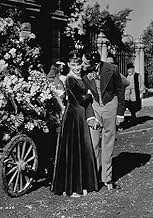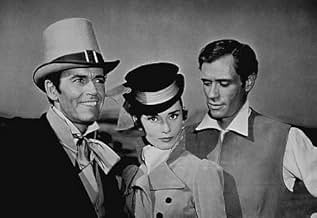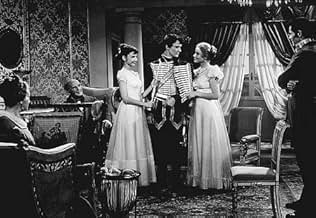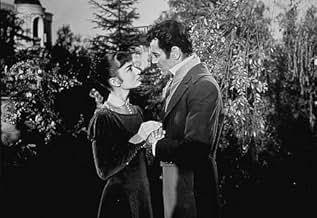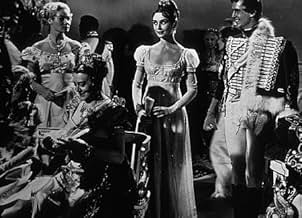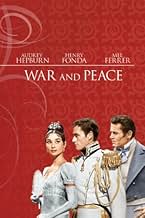As tumultuadas relações de Napoleão com a Rússia, incluindo sua desastrosa invasão em 1812, servem como pano de fundo para a vida pessoal emaranhada de duas famílias aristocráticas.As tumultuadas relações de Napoleão com a Rússia, incluindo sua desastrosa invasão em 1812, servem como pano de fundo para a vida pessoal emaranhada de duas famílias aristocráticas.As tumultuadas relações de Napoleão com a Rússia, incluindo sua desastrosa invasão em 1812, servem como pano de fundo para a vida pessoal emaranhada de duas famílias aristocráticas.
- Indicado a 3 Oscars
- 6 vitórias e 13 indicações no total
- Prince Bolkonsky
- (as Wilfred Lawson)
Enredo
Você sabia?
- CuriosidadesAudrey Hepburn's character was supposed to be thirteen when the movie begins. She was twenty-seven when this movie came out.
- Erros de gravaçãoThe marching band in the opening parade are all playing modern musical instruments.
- Citações
Prince Andrei Bolkonsky: There must be something you want to do.
Pierre Bezukhov: I want to discover... everything! I want to discover why I know what's right and still do what's wrong. I want to discover what happiness is, and what value there is in suffering. I want to discover why men go to war, and what they really say deep in their hearts when they pray. I want to discover what men and women feel when they say they love.
- Cenas durante ou pós-créditosClosing credits epilogue: The most difficult thing - but an essential one - is to love Life, to love it even while one suffers, because Life is all. Life is God, and to love Life means to love God. Tolstoy "WAR and PEACE"
- Versões alternativasTwo different versions of the main titles exists. Both of them in English. In the one, the credits are set against a neutral background, in the other against details of a painting of Napoleon in front of his troops.
- ConexõesEdited into Bill & Ted: Uma Aventura Fantástica (1989)
The narrative here focuses mainly on just three of Tolstoy's characters – Pierre, Natasha and Alexei – portrayed by Henry Fonda, Audrey Hepburn and Mel Ferrer respectively. Fonda is really too old to play the youthful Pierre, but he is not as severely miscast as some have said, pulling off the early scenes of Pierre as the gangly, drunken student with a fair degree of believability. Hepburn brilliantly handles the aging of her character, transforming the naïve teenager into a mature and confident woman while still maintaining the same core persona. If only something as complementary could be said of Mel Ferrer, who takes to acting the same way anvils take to floating. His appallingness is matched only by the woman who plays his wife, Milly Vitale. There are some decent supporting players though. Herbert Lom gives a surprisingly heartfelt performance as Napoleon. Oskar Homolka brilliantly plays the archetypal scruffy old general who's too high-ranking and experienced to bother with all that decorum business, his gestures forceful but with a half-hearted brevity to them. And John Mills is bizarrely like someone out of a Monty Python film.
Director King Vidor was a veteran of old Hollywood and just the sort of director to handle the mix of big canvas and intimacy. He shows what must have been extraordinary patience in setting up hordes of extras, carts and cannons for authentic looking crowd scenes, but then makes them a briefly glimpsed backdrop, never really dwelling on the massive scope or showing it off for its own sake. This seemingly contradictory tack gives us a sense of the story happening in a real place, but never allows it to detract from the main players and their stories. Vidor is constantly implying things with the simplest of cinematic tricks, and this helps to make up for the gaps in plot that the adaptation necessitates. For example, when Hepburn and Vittorio Gassman kiss at the opera, the angle gradually changes to reveal the reflection of a door in a mirror. This subtle move plants the idea in our heads that someone may walk in on them, and it gives the moment a sense of unease and wrongness. Vidor's canny ability to suggest mood and temperament, particularly evident in his framing of the inner monologues during the dance scene, also helps to cover any deficit in the acting.
At three-and-a-half hours, this is still quite a long old movie. And yet, thanks to some compelling imagery and strong narrative it moves faster than many a 90-minuter. Shorn of much of Tolstoy's original material as it is, it is still long enough to give us that feeling of the passage of time and development of character, to make Fonda's transition from a foppish lad in Western European attire to a bearded man in Russian garb feel like more than just a change of clothes. This version of War and Peace certainly has a fair few things wrong with it, yet still manages to be a lucid and passionate – if not entirely faithful – adaptation of a great work of literature.
- Steffi_P
- 4 de set. de 2011
- Link permanente
Principais escolhas
- How long is War and Peace?Fornecido pela Alexa
Detalhes
- Data de lançamento
- Países de origem
- Central de atendimento oficial
- Idiomas
- Também conhecido como
- War and Peace
- Locações de filme
- Empresa de produção
- Consulte mais créditos da empresa na IMDbPro
Bilheteria
- Orçamento
- US$ 6.000.000 (estimativa)
- Faturamento bruto mundial
- US$ 24.874
- Tempo de duração3 horas 28 minutos
Contribua para esta página



